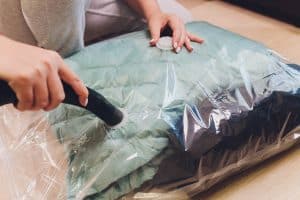As the fall season approaches, many people have clothing on the mind. From shopping for back-to-school clothes to finding a place to store summer clothes until next year, the need for clothing storage ramps up. Unless you have a spacious walk-in closet, odds are you store your clothes by season for space-saving and functional purposes. Our customers in geographic areas with distinct seasons, as well as those in more temperate climates, can declutter by moving unworn clothing to a specific storage location.

KonMari Your Clothing
We’ve discussed Marie Kondo’s KonMari method in the past and are big believers in this organization practice. As the seasons change, this is a great opportunity to review your wardrobe and remove items you no longer wear or want. One good guideline is to take any clothing you haven’t worn in a year and pass it on through donation or consignment. Sort through your clothing and, once you’ve removed the unworn items, you’ll be better prepared to store and organize what you are keeping.
For readers with children, this method will help you as they grow out of clothing. Children’s clothing can be donated to a local charity, passed down to a younger friend, or consigned at a children’s clothing shop.
Wash Everything
After you’ve removed the clothing you won’t be keeping, wash everything you want to put in storage. Washing your clothes is crucial to the longevity of your wardrobe. Unwashed clothes may produce mildew, mold and begin to smell musty. Sweat, oils, lotions or residual perfume can also turn your clothing yellow if it sits unwashed for too long. If you read our blog last month, you’ll also know that food stains on clothing can attract pests, which can ruin them.
Choose Clothing Storage Containers Based on Contents and Location
For clothing storage, we recommend choosing plastic bins, as they are great at keeping moisture and pests out, as well as being easy to handle and stack. Clear bins may be helpful in determining at a glance what is inside, but if they’ll be exposed to direct sunlight, this can cause your clothing to fade. Dark-colored plastic bins are a great option for clothing storage. We recommend avoiding cardboard boxes because they can attract pests and don’t offer moisture protection. Cardboard boxes should only be used when storing clothes inside your home.
Organize your clothing storage by season and activity and label the bins accordingly. This makes it easier to pull out exactly what you need when you need it. If you plan on storing off-season clothing for multiple people in your household, consider placing each person’s clothing in a smaller bag and then storing those bags in the same bin together, since you’ll likely need ski jackets at the same time, for example.
Vacuum-Seal Bags to Save Space

Store Clothing in a Dry, Dark and Cool Place
Light causes fabrics to fade. Extreme changes in temperature can be damaging to your clothing. Certain areas of your home are more susceptible to extreme temperature changes and are brighter than others. We recommend a climate-controlled storage unit for clothing storage. Climate-controlled storage units are maintained within a set temperature range, providing you with the ideal environment for long-term clothing storage.
In the home, a wardrobe can be used to store clothing, which provides a dark, dry, cool space. If your home has a large walk-in closet or dressing room, this would also be a great place to store off-season clothing, as long as it doesn’t prohibit everyday use of the space. A few additional places to store clothing include:
- Under the bed, either in bins or in under-the-bed drawers
- Suitcases
- Mudroom storage areas
- Extra cabinets in other rooms of your home
If possible, store clothing in climate-controlled spaces. Stable storage conditions with consistent temperatures help preserve your clothing as well as possible. You can use a basement if it’s not too damp. We typically don’t recommend attics, as they are often hot and dusty, which isn’t the ideal environment for clothing storage.
Protect Your Clothing — Rent a Storage Unit at SPS
At Security Public Storage, we know clothing storage is important. When you find that favorite pair of jeans, it’s important to preserve them until you can bring them out of storage in the fall. By storing your off-season clothing in a storage unit at SPS, it will make your everyday use of your closet much easier. Easily access your storage unit to pull out whatever clothing you need by season and reclaim space at home. Remember to donate unwanted clothing, as it will benefit someone else who may need it.
Interested in clothing storage? Browse our locations to find a storage facility near you!
